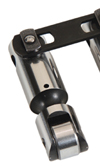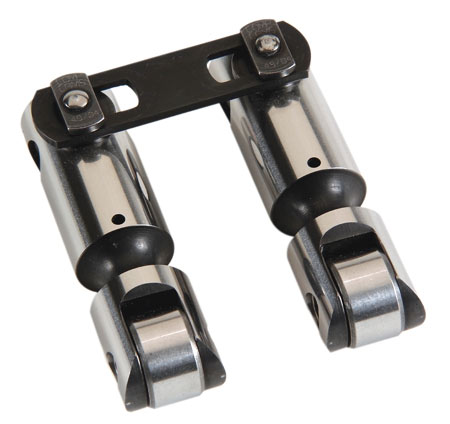Lifters - flat versus roller
 In the RET magazine Focus article on pushrod valvetrains (issue 45, March/April 2010), we looked at the effect of flat tappets in limiting the lift velocity of a direct-acting cam on a lifter. The limitation is exactly the same as that in direct-acting overhead camshaft engines. Textbooks on the subject tell us that the distance of the cam-to-lifter contact from the axis of a flat tappet is proportional to the lift velocity of the cam profile. The exact relationship is shown in mathematical form in the RET article.
In the RET magazine Focus article on pushrod valvetrains (issue 45, March/April 2010), we looked at the effect of flat tappets in limiting the lift velocity of a direct-acting cam on a lifter. The limitation is exactly the same as that in direct-acting overhead camshaft engines. Textbooks on the subject tell us that the distance of the cam-to-lifter contact from the axis of a flat tappet is proportional to the lift velocity of the cam profile. The exact relationship is shown in mathematical form in the RET article.
What we can say is that the faster the cam tries to lift the valve in an angular sense (measured in inches per degree, millimetre per radian and so on), the larger the distance 'swept out' by the cam profile across a given flat follower. Where the tappet size is the limiting factor for lift velocity, a common development is to use larger diameter tappets. However, in race series such as NASCAR Sprint Cup, the diameter of the tappet/lifter is limited to a maximum value in the regulations. In the case of Sprint Cup engines, this diameter is 0.875 in (22.22 mm). Lifting at too fast a rate will see the cam contact reach and go past the edge of the camshaft. By going too far over the edge, we can reach a point-contact condition that is very bad for friction and wear, owing to poor lubrication conditions and high contact stresses, which can lead to subsurface fatigue.
Limiting maximum lifter diameter is one method by which engine performance may be limited, or certainly aggressive development in the direction of increased lift velocities is curtailed. People will always try to push these limits, by taking the cam/lifter contact as close to the limit as possible, but also looking to maximise the cam angle over which high lift velocities are maintained.
Where rules don't limit lifters to be of the flat, solid type, people will generally turn to roller lifters, as the relationship between lifter velocity and contact point is very different. As the name suggests, a roller lifter has a rolling element incorporated in the lifter foot. These need to be carefully aligned so that the axis of the roller is perfectly parallel to the axis of the camshaft. They don't need to be constrained tightly to achieve this as the action of the cam on the roller tends to self-align the lifter perfectly to the cam. Generally though, they are constrained within certain limits, and typical methods of doing this are keyways, tie-bars and flats on the lifter which align with corresponding features on adjacent components. The devices guard against the tappet axis finding itself perpendicular to the camshaft axis at engine start-up where damage might occur.
Keys fitted in the lifter require a corresponding keyway in the lifter bore, slightly complicating the machining of the cylinder block, but these are very popular, given the very small amount of extra reciprocating mass required to prevent lifter rotation.

'Dogbones' or tie-bars, which are a connecting 'link' between adjacent lifters, are an easy fix to the rotation problem and can run in plain cylindrical bores, requiring no special machining on the block. The do however carry a larger weight penalty and so aren't often used for highly optimised race engines.
Flats machined onto the lifter can be a simple method of restraining rotation, and there are a number of ways in which these can be used to prevent lifter rotation. Corvette for example uses a 'lifter tray' with corresponding flats in its production vehicles.
In the NASCAR Camping World Truck series, roller lifters are mandated but, given a choice, everyone would use these anyway as they allow much more aggressive lift profiles without the risk of component damage. In the real world of production automotive engines, where there is no restriction concerning maximum lifter diameters and no obstacle barring the use of roller lifters, the flat lifter is an anachronism and they are now only very rarely used.
Fig. 1 - A tie-bar or 'dog-bone' is an effective way to align roller lifters with the camshaft, but they carry a weight penalty (Courtesy of Comp Cams)
Written by Wayne Ward